Being prepared for emergencies means being able to generate electricity without the grid. There are bigger solar panels for your home and basecamp, but many preppers want to charge their portable batteries and USB-powered devices (e.g. phones) while on foot. These portable solar panels, which are typically marketed for backpacking, hiking, or camping, are a core part of many people’s go-bags and car kits.
Reviews: Portable battery banks and removable rechargeable batteries.
Portable solar chargers pair well with a rechargeable battery pack (either a single Li-Ion pack or a charger for AA-style batteries), and some of them even come with a built-in battery pack.
Despite how simple these USB solar chargers appear — you put them in the sun and plug your gear into them, right? — there’s a lot more to picking the right charger and learning how to use it effectively than you might imagine.
More: Check out the beginner’s guide to off-grid power for the basics in simple terms and what kind of gear you need for your goals.
The basics:
- Bigger panels always perform better. Get the biggest you can within your space, weight, and budget limits.
- Time of day doesn’t matter nearly as much as placing the panels perpendicular to the sun.
- Despite what you might read in guides, it appears to be very rare for panels to not go back up to full power after a cloud passes overhead. This may have been an issue for older panels, but it seems to have been fixed in the current generation.
- Heat decreases panel performance, so keep your panels off of hot surfaces like stone or metal. Some of the panels that heated up quite a bit had rapid voltage and current oscillations, and these wild swings lowered the total overall energy output over the course of a test run.
- Avoid charging your phone/headlamp/whatever directly from a solar panel in the hot sun. Rather, charge a battery pack first, then use that pack to charge your phone.
Read below the fold for deep details on our testing methods and data, tips on getting the most from your panel, and more.
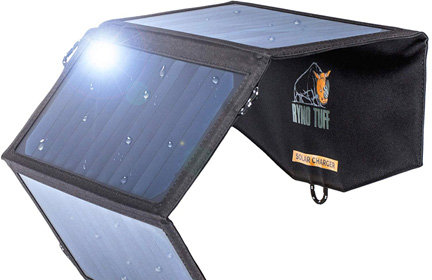
Best for most people:
Ryno Tuff 21W USB Solar Charger
The best portable solar panel for most people is the Ryno Tuff 21W. After hours of testing with a load tester and a multimeter, this charger ranked at or near the top of our review in the key areas of power output, watts per ounce, and efficiency. As we measured weather, sunlight levels, and panel heat in a variety of conditions, the Ryno Tuff was able to maintain an impressive 10W on a single USB port. In fact, we even got it all the way up to 12W for a bit on one test run. The price is also right — often coming in $5-10 cheaper than the competition — to the point that not only is it the overall winner but it’s the best budget option as well.
As of June 2022, customer service seems to be non-existent for Ryno Tuff. It is a quality panel and is still being sold by reputable sellers, but do not expect any sort of warranty or customer service.
We strongly recommend pairing a solar charger with a separate external USB battery bank so that you don’t have to ruin your gadgets built-in batteries by baking them in the sun during a charge cycle. Many of the products in this guide sell versions with and without a battery built into the solar charger. Although we prefer keeping the charger and battery separate, it’s not wrong if you pick the built-in battery version.

CHOETECH 19W USB Solar Charger
The CHOETECH 19W is a great alternative — if you can find the CHOETECH for about the same price as the Ryno Tuff, confidently grab whichever one you’d like. The CHOETECH weighs the same as the Ryno Tuff yet folds into a slightly more compact design that saves precious space in smaller bags. The build quality is solid, just like the Ryno, but we did like the CHOETECHs embedded metal rings more than the cloth loops on the Ryno. This panel produced slightly less peak power than the Ryno in most of our testing, but the overall performance is close enough in most conditions.
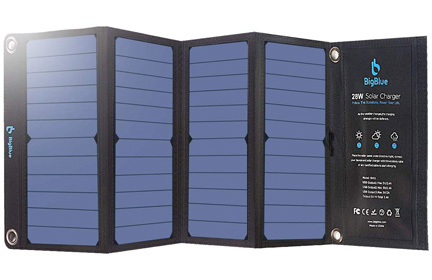
Great for low light:
BigBlue 3 28W Solar Charger
On the other hand, grab the BigBlue 28W Solar Charger if you want more power and are willing to deal with a larger panel. Total panel area directly affects power output — especially when dealing with constant low-light conditions — so preppers in locations like the Pacific Northwest may need to bite the bullet and carry a bigger charger if they really care about power preparedness. The BigBlue features three USB ports and did very well in our tests. The extra size makes it one of the heaviest chargers in our review, but on cloudy days it produced twice the output (8W vs 4.5W) of the Ryno and Choetech.
Although the BigBlue has a smaller height and width than the Ryno Tuff, the extra panel makes it heavier and thicker when folded up. The Renogy is much smaller and lighter than both.
- Difference between advertising and reality
- Angle to the sun matters
- Panel size directly impacts power
- How long will it take to charge my phone?
- How to figure out your device charge times
- Why USB charging is weird
- How we picked the competition
- How we tested
- Why other hiking solar charger reviews are flawed
- Nerdy notes on how to read the full test results
- Review data for each panel
Common sense prepping, straight to your inbox.
Get our free newsletter for great new articles and giveaways. 1-2 emails a month. 0% spam.
Advertised numbers don’t reflect reality
Our testing shows that real-world performance almost never reaches what the companies claim. At best, you should use those numbers to understand relative differences between products. If you have specific numbers you need to hit, such as watts or amps, assume there’s at least a 25-50% drop off from the marketing data.
Most USB chargers have names like RAVPower 16W, with the 16W label referring to the amount of power in watts. But manufacturer-provided power ratings are generated under highly artificial test conditions in order to promote the highest number possible.
It’s better to use those advertised wattage numbers as a rough indication of general panel size and relative power performance — e.g. a panel labeled 20W is probably a bit stronger and bigger than one labeled as 10W, even though neither panel will hit their advertised numbers.
Similarly, we found the amps coming out of a USB port almost never reached the rated maximum. For example, one panel that advertised 2.4 amps of USB output actually never got above 1.8.
Power output greatly depends on angle to the sun
Our testing found that how the panel is angled relative to the sun matters a lot more than simply the time of day. A panel at a bad angle at high Noon will perform worse than the same panel pointed directly at the sun at 6 PM. Even a few degrees off of 90/perpendicular makes a noticeable difference.
Some of these chargers hit maximum output even as late as 7 PM — just through proper positioning.
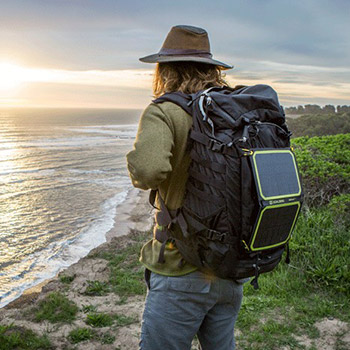
You know all those marketing pictures where the panel is strapped to the back of a hiker’s pack, using the attached loops that are helpfully built into the panels for that express purpose?
This will only work if the sun is directly behind you or you can get some portion of the panel on top of the bag. Vertical almost never works, especially if you keep changing the orientation of the panel to the sun.
You don’t have to baby the panel every few minutes, just be smart about your positioning. Worst case: lay the panel flat through the mid-day hours.
To see how important the sun angle is in real wattage numbers, here’s a graph of an orientation test with the BigBlue 3 28W panel on a sunny, early September day at about noon.
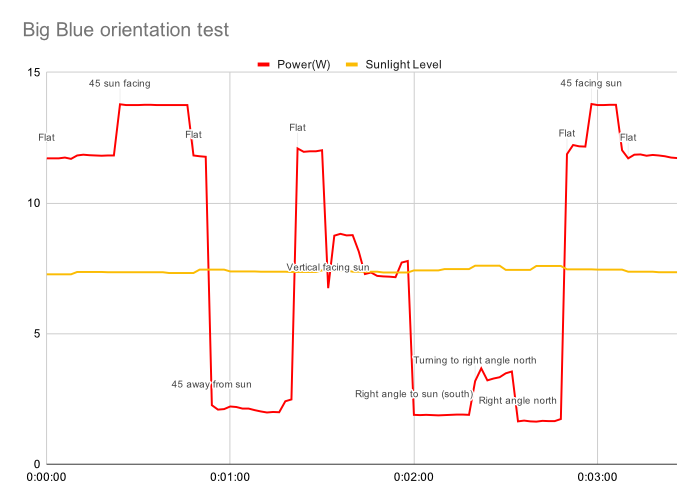
We rotated the panel through a series of positions while making an audio recording of calling out the positions and timestamps so that we could mark them on the graph above. You’ll see that the sunlight level is constant at about 750W/m2, but the panel’s power output swings wildly with each position.
As we moved the panel from flat to 45 degrees from the sun, for example, the power output jumped from just under 12W to 14W. Turning the panel to 45 degrees facing away from the sun dropped the power output all the way down to two watts.
Total panel size is the biggest power factor
Regardless of the brand, technology, or price, total panel surface area is the number one factor behind solar charger performance. You can’t beat this by throwing money at it, either — for max power and best output under a wide range of conditions, it’s generally better to go big and cheap than small and expensive.
The scatter plot below compares each charger’s total panel area (in square meters) against the average power output during the best-performing test run. For the scientifically inclined, there’s a strong correlation with a p value of 0.8.
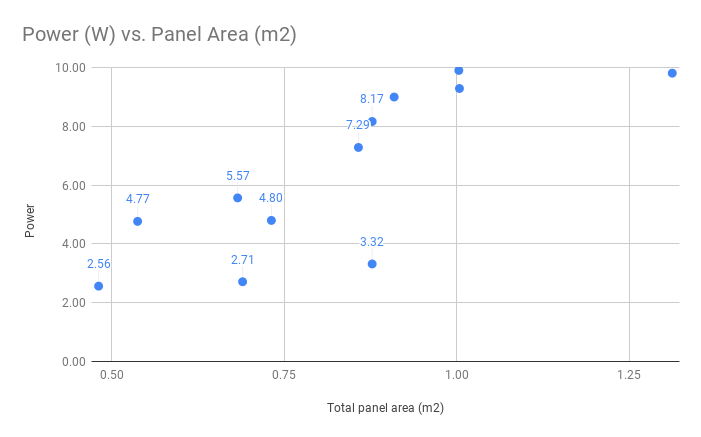
Chargers with smaller overall panel area were also more sensitive to a wider range of sunlight conditions. It took more sunlight to max them out, and they dropped off quickly under less-than-ideal light.
Although bigger is clearly better, the idea is to be portable, which is why we chose not to include panels we felt were too big for a common go-bag. Just get the biggest you can within your space, weight, and budget constraints.
How long will it take to charge my phone?
The main question — in most cases the only question — that everyone wants an answer to when shopping for portable USB solar chargers is: how long will this take to charge my phone if I put it in direct sunlight?
Like it or not, the answer is “it depends.” There are so many different factors that go into that question that any blanket answers are lying for the sake of ease.
Consider answering “which car can drive furthest on a gallon of gas?” To test that, you’d need everything else to be the same — the same tires, same route, same weather conditions, same type of oil and gas, same weight in the vehicle, and so on.
Similarly, different solar chargers behave differently depending on weather conditions, angle to the sun, temperature, the type of device they’re plugged into, etc. And different chargeable devices have different battery chemistries, capacities, charging algorithms, etc.
Later in this review, we explain how we handled those differences to be as scientific as possible and why most other portable solar charger reviews you see online are inherently flawed because they aren’t measuring apples to apples.
How to figure out your device charge times
Two numbers matter when charging any kind of battery: watt-hours (Wh) and volts (V).
Each battery holds a certain number of watt-hours of energy. So for an empty 9Wh battery, you need to supply it with 9 watts for an hour or 4.5 watts for 2 hours (and so on) to bring it up to full charge. The more watts your charger puts out, the faster your gear will charge.
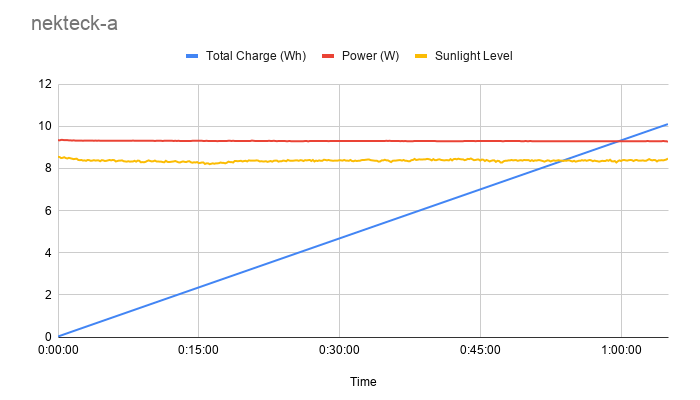
This chart shows the amount of sun a test panel received over an hour (yellow) which was consistent on a sunny day, how much power the panel put out from that sunlight at any given moment (red/watts), and how much cumulative energy was sent to the USB device (blue/watt-hours).
Think of the blue line as the total charge sent into a battery, which is why it builds over time.
So as you look through the test run charts for the different panels in this review, keep your eye on how that Wh line grows over time under different sunlight conditions to get a feel for how the panels would perform on different battery sizes.
For example, the Nekteck charger in the graph above created 9.3Wh of charge over an hour. Since an iPhone XS battery is 9.8Wh, it would’ve charged to about 95% (from zero) in an hour. Again, though, these are ballpark numbers, because the iPhone would vary its voltage needs and current draw from the panel as its internal battery progresses through its charge cycle.
Why USB charging is weird
The kinds of lithium-ion batteries you’ll usually be charging via USB spend most of their usable battery life at 3.7V, but you’ll need to charge them at a minimum of 4.2V to get them up to 100 percent full. Depending on the specifics of the battery there may be a little wiggle room, but 4.2V is what you should aim for.
USB charging devices — whether they’re battery packs or solar panels — have USB ports with nominal 5V outputs. That 5V rating is a USB standard when charging a battery, but what differs from one USB flavor to another (-A, -B, mini, etc.) are the amps the port can put out. For example, many older USB flavors can charge a battery at 1.5A, but some newer fast-charge flavors run at 2.1A.
The USB ports on the solar chargers we tested rated at different amperages, so in our spreadsheet we list the maximum amperage of the highest amperage port on each charger.
These amperage and power differences among ports solely affect how quickly a given device will charge when plugged into them. They do not pose a safety hazard for the following reasons:
You definitely cannot fry your phone by plugging it into a port that gives too much USB power. A 5V + 2A = 10W USB port does not “push” 10W of power into whatever you plug into it. Rather, your device can pull up 10W — or whatever the rated maximum of the port is — at a time. So there is no danger of frying your phone if you plug it into a USB charging port that’s capable of putting out way more power than it can use. The phone will draw as much power from the port as it can, and the port won’t try to give the phone any extra power.
You probably cannot fry a USB charger port by plugging the wrong phone into it. Your tablet could try to pull 20W out of a 10W USB port, but if that USB port has overcharge protection then it will be fine. Most of the panels we tested don’t advertise overcharge protection, but this is so standard we’d be shocked if it’s not universal on these products.
How we selected the contenders
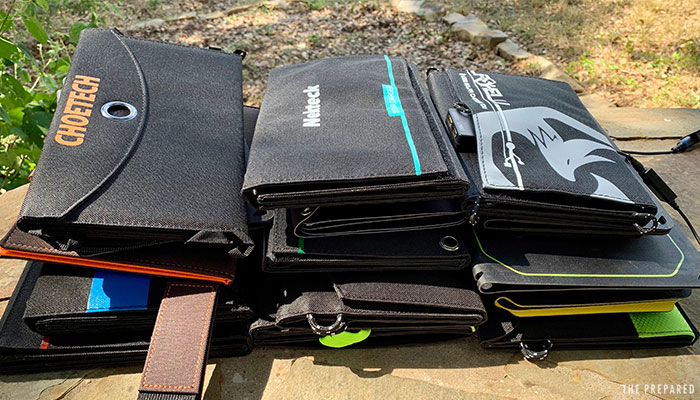
We created a spreadsheet of 26 panels after researching other reviews and scouring through preparedness, outdoor, and electronics forums for common recommendations. From there we chose the models that seemed like the best candidates, narrowing the field down to 15 for in-person testing.
Although size is always an issue, we focused on panels with advertised power over 10 watts, except for the Goal Zero Nomad 7, which we included due to its popularity among preppers. Most of the panels were provided by the manufacturer, but that never breaks our Prepared Promise.
How we tested
Besides normal qualities like price and durability, our goal was to isolate the panels and test their efficiency under different weather conditions, honing in on what kind of power output you can get depending on sunlight and changing environmental conditions.
Properly testing portable chargers takes a lot of time and specialized equipment. We’ve yet to find another review online that does this properly (details in next section).
We bought an irradiance meter to measure the energy of the sun hitting the panel, a multimeter to measure the output from the panel’s USB port, and a USB load tester that acts like a battery (but with smart controls so we could change current draw).

We laid each panel out flat in the sun on an elevated Coolaroo pet bed over a light-colored stone deck so that air could circulate underneath. We placed our testing apparatus in a small box underneath the bed/panel for shade, with the irradiance meter’s sunlight sensor in the same place for every test.
That measuring gear logged lots of data over each testing session (typically a sample every 10 seconds), which we collected with a custom computer script to analyze the data and turn it into charts.
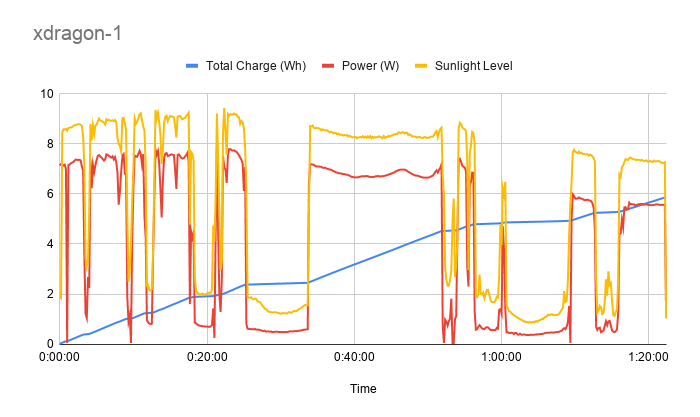
Our testing site was in central Texas, two miles from an airport. We recorded the METAR weather and sky condition data from that airport for the main run of tests.
Because ambient temp affects panel performance, we also tried to get a sense of how well panels handled the heat while baking in the sun by using the thermal FLIR camera built into a CAT S61 smartphone.
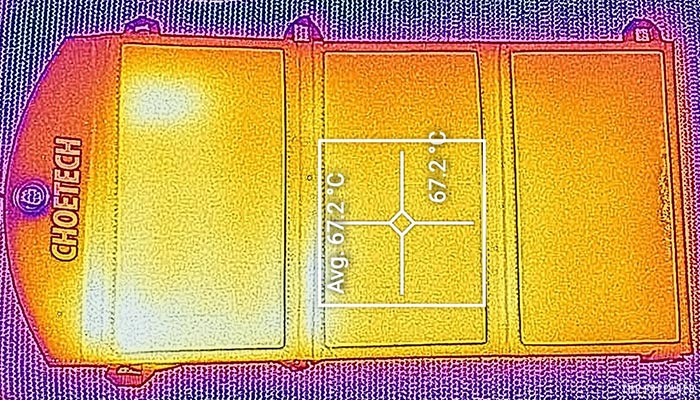
Additional nerd notes
- All measurements were taken from the first USB port, or from the quick-charging port if the panel had one.
- The USB load tester was set to draw two amps of current. If the panel’s output dropped too low, it would lose power, but every time it switched back on it immediately began drawing current again at the same two-amp level.
- The USB multimeter was powered by a separate USB power input, so if and when the panel dropped out due to cloud cover it would keep recording.
- The duration of most of the tests was at least one hour, though we often let panels run for far longer to get a picture of how they performed under a wide range of conditions.
- The panels were brought out from an air conditioned house and plugged immediately into the testing apparatus, so all of the tests reflect a rise in panel temperatures over the course of the session.
- We only tested one USB port, even if the charger had multiple, because with panels of this relatively small size you really want to charge one thing at a time.
- You’ll see from our test data that by pushing up the amperage we were able to max out even the largest panels with just one port filled, so we’re confident that our ranking of the panels still holds even if we loaded more than one port.
- In general, most of the panels seemed to do best when you’re trying to pull less than the stated maximum current from them, and slightly worse when you’re at the maximum amperage or above it.
- As a result, rather than tune the current draw for each panel, we chose to use a constant 2A. Tuning the draw for each felt like that was more about testing the advertising claims, which was less important than real-world use.
- We chose 2A because the advertised USB output amperages ranged from 1.4A to 3A, with many at or close to 2.4A, so we erred on the low side. 2A also felt like the right threshold to reflect modern smartphones, tablets, etc.
- Because some of the panels, especially the smaller ones, really performed poorly under the 2A load, and the larger ones that could do more amperage were limited by it, we did some shorter test runs at different amperages ranging from 1A to 3A, depending on the panel.
- We used in the results from these shorter runs when they seemed appropriate, and weren’t dogmatic about only using the number from the 2A load. The idea is to get a realistic picture of what each panel can do, while also coming up with a meaningful way to rank them fairly.
Why other hiking solar charger reviews are flawed
As we researched this space, we were shocked at how unscientific and misleading other top-tier reviews are — so although we like to avoid talking about competitors, we decided to share our thinking in hopes of raising the tide in this market.
Most other sites went the quicker and cheaper route by taking the panel outside on a sunny day, plugging a partially charged Li-Ion battery into the panel for a set period of time, then judging the results solely by how many % points the battery increased (e.g. 10% to 15% charged). Panel A that increased a battery by 8% “won” over Panel B that went up 6%.
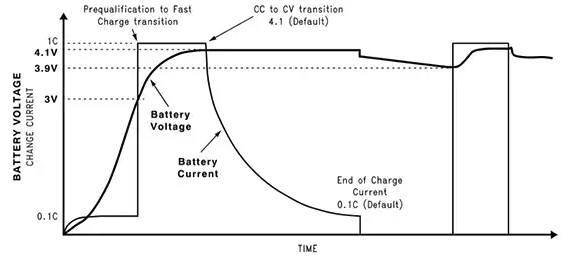
The problem here is that Li-Ion has a charging curve, so depending on what charge level you start at, it will take either more or less power to add percentage points to the charge meter. So unless they’re using the same battery at the same level of partial charge every time, the tests aren’t quite fair.
More sophisticated sites will fully drain a battery pack, then plug it in and charge it, measuring the cumulative charge with a power meter. A few took it a step further, “confirming” the results by draining the bank back to empty and measuring the cumulative output.
That’s an improvement, but it’s still partially testing the battery and not just the panel in isolation. The battery’s temperature and the rate at which it’s charged and discharged both impact how much charge it holds. Which means temperatures and other factors will skew the results.
Some sites will do spot tests of the maximum panel output, reporting that the panel peaked at X volts and Y amps. That’s just as flawed as claiming a car can do 50 miles per gallon because the reviewer measured the gas efficiency while rolling downhill while idling. As you can see from our results, some of the panels go through periods where their output fluctuates wildly. Taking a partial snapshot doesn’t paint the whole picture. A proper test will measure performance and variables over time.
Finally, perhaps the most serious problem with the most popular solar panel tests is that there is not a single solar irradiance measurement in them — in fact, there’s often not even a weather report!
Solar irradiance (watts per meter squared) is the energy hitting the solar panel. The temperature of the panel affects its efficiency at converting that irradiance into electricity. So when they fail to take careful measurements of both the sun’s energy and the panel temp, it’s impossible to compare apples to apples. Vague talk of “sunny” or “passing clouds” isn’t nearly precise enough.
How to read the full test results
Sunlight (“irradiance”) is shown as a number like 600 w/m^2. In simple terms, that’s how much energy hits a surface that’s one square meter (about 10 square feet). We broke 1,000 w/m^2 on a 108F bright Texas day, otherwise a normal sunny day with the sun directly overhead was in the 750-900 range, partly cloudy or with the sun at an angle would be 500-750, and real cloud cover would get down to about 120. On the charts, we divided these numbers by 100 to get them in the 0-10 range.
Power (watts) = volts x amps. In general, the panels held a steady voltage while the amperage varied a bit. You can get the base numbers for voltage and amperage from the spreadsheet for each test run.
Energy (watt-hours) is a running total of the power put into a battery over time. If the devices you care about have batteries measured in mAh (milliamp-hours), the beginners guide explains how to convert so you’re apples to apples.
Efficiency: The real panel efficiencies we measured were in the 0.2% to 1.5% range, so we multiplied by 10 to fit them into the charts alongside power. Much more on this in a following section, though.
Focus on the power output, not the voltage
If you dig into the test data, you’ll see that few of the panels ever got up to the 4.2V needed to fully charge the average Li-Ion battery, much less stayed there over the course of a run. This is not as big a deal as it may seem.
Just focus on the power column. Since power = volts x amps, you can get 5W of power from 2.5V x 2A, or from 5V x 1A. For one test we may have dialed in a 2A load that’s only showing 2.5V, but if we dial it back to 1A on another run then we can always get closer to 5V.
Here’s what’s going on: Most modern USB devices, whether it’s a battery bank or an e-reader, have a controller chip that will intelligently charge the internal battery when you plug them in to one of these panels. So the chip will alter the charging port’s current draw to suit the battery’s voltage needs for whatever part of the charging cycle it’s at — if it’s early in a charge cycle, it may need a lower voltage and/or current than at the end of the cycle.
We ran a number of shorter tests on the panels that didn’t make it above 4.2V in the main test runs, in order to directly confirm that if we dial down the current draw to about 1 amp, the voltage gets well north of 4.2. So even the panels that have voltage readings in the 2.5V range will get up to 4.2V and fully charge a battery if you lower the current draw, as long as the device that battery is in has a charge controller that can manage the process by varying the current.
Understanding solar charger efficiency
Solar panel efficiency is expressed as a percentage of watts out divided by watts in. So we measured the watts/m^2 given off by the sun during each test run, multiplied that by the total area of each charger’s panels in square meters, and divided the measured wattage output by the results.
We never got real efficiency numbers over about 14% for even the best of these chargers under the most ideal conditions. This is below the 20% to 25% efficiency numbers advertised.
It could be that the panel technology is that efficient under some ideal lab conditions, but by the time they package it into a charger and hang some USB ports off it, that efficiency is lower.
Aeiusny 20W Solar Charger
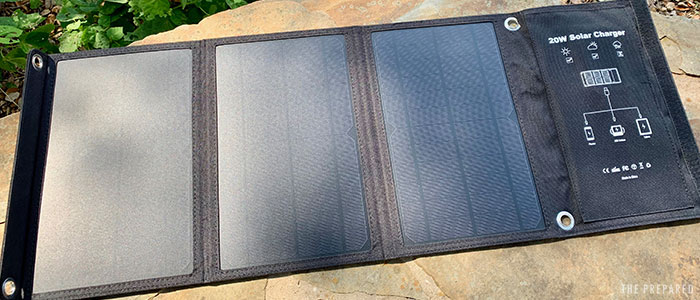
Bottom line: The $70 Aeiusny 20W Solar Charger is a large, heavy unit that we expected big things from based on the size, but we were disappointed by the performance. We couldn’t get the panel’s power output to stabilize, and because the power output was all over the map, it didn’t put out much total charge on any given test run no matter how ideal the sunlight conditions were.
We liked the integrated rings and the build quality is decent. But given the problems we encountered, we can’t recommend the Aeiusny. We’ll hang on to it and revisit if the manufacturer fixes or clarifies the issues.
Test notes: This is one of the panels we suspect may be hampered in our tests by some sort of “smart” device auto-detection circuitry. The charger touts the following feature on its Amazon listing page:
“SMART IC TECHNOLOGY: The Aeiusny Solar Panel has Smart IC Technology that detects the device using USB PIN signals and provides optimal charging power and optimal charging speed for both Android and iOS devices simultaneously, automatically adjusting to the demands of the device.”
You can see from the charts that the charger’s power output is very spikey, with the first test run seeing the current swing from about 2A down to 0.5A to 0A to 1.5A, as if it’s hunting around from among the standard USB current levels to find the correct one.
We’re not entirely sure what happened on the second test, but it’s most likely that the panel wasn’t plugged into the testing apparatus all the way, so the trace amount of power in the chart is actually coming from the USB power input and not from the panel input.
As for the third test, the irradiance meter was accidentally not recording, but the sky was perfectly clear with no clouds, so there wouldn’t be any cloud cover reflected in it, anyway.
On the fourth test run, which was done with the load tester set to draw 3A of current, you can see that the panel spent most of its time close to zero, with the current spiking upwards periodically to between 1A and 2A. It’s as if the tester’s attempt to draw a higher load really threw it for a loop.
Or, it could be possible that heat is the main reason for the wild power swings, since in the first and third test runs the panel stays stable for about 15 minutes before starting to go all over the place.
There’s a chance the panel technology is a culprit. We noticed this same all-over-the-place power output pattern from other products with a similar look to the panel cells (e.g. the Foxelli charger), which often indicates a shared supplier or factory.
BigBlue 3 28W
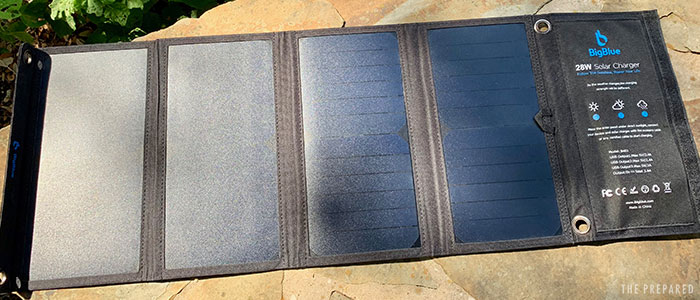
Bottom line: The $70 BigBlue 3 28W is a large, high-quality panel, with extremely clean power output that correlates tightly with sun input. You can see how clean the power and efficiency plots are for most of the tests and how rock solid the power output stays during full sunlight conditions.
The build quality for this panel is good but not exceptional, as it’s the standard polyester cover with embedded metal rings. It seems to have stayed cool enough, even in the summer Texas sun, to stay stable and efficient. We didn’t see any bubbling or other damage from heat.
The main downsides to this panel are size and weight. We included it because we saw many other people considered it just under the limit for a backpack-portable charger. In exchange for its higher weight, this panel does extremely well in lower sunlight conditions. The BigBlue did far better in moderate sunlight than any other panel in this roundup, getting up to 8W in conditions where the other panels would’ve struggled to produce 4.5W.
Test notes: For most of the runs, we had the load tester set to draw 2A of current, which the charger stayed close to at a steady 4.9V.
For the “bigblue-3” run, we had the tester try to draw 3A. The charger put out well above 2A for most of that run, and even got all the way up to 2.5A — above its rated 2.4A maximum — for a little while.
Like the power line graphs, the power and efficiency scatter plots are exceptionally clean, and reveal that this is one of the panels where efficiency drops a bit as the sunlight level maxes it out and the power output plateaus.
CHOETECH 19W
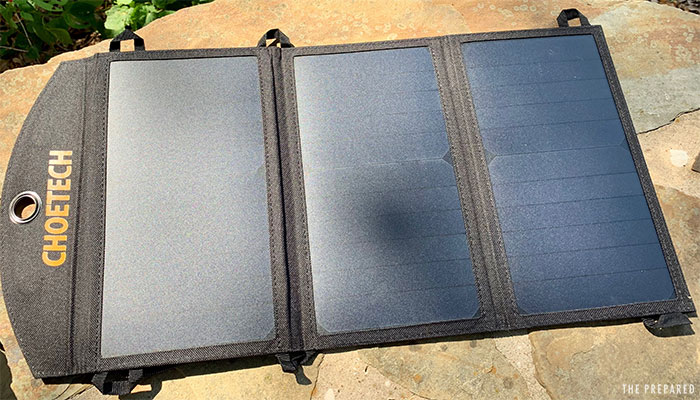
Bottom line: The $55 CHOETECH 19W is exceptionally lightweight and compact for the amount of juice it produces, coming in under a pound. We have no complaints about the overall build quality, and we appreciate that there’s not a lick of extraneous material to weigh it down. Excellent performance at a great price in a compact package.
The output from the CHOETECH charger was very stable under all sorts of conditions, holding steady during periods of ideal sunlight and correlating tightly with dips and rises from passing clouds. We were able to get a sustained 4.5V at 2A for a steady flow of 9W of power to one of this two USB outputs when the weather cooperated.
This panel has one integrated metal ring in the top, and then loops along the side. These woven loops are the price of not wasting space on the cover, though. If it has integrated rings, it would weigh more because they would have to expand the amount of extra case material all the way around to accommodate them.
The one slight downside to this panel is the efficiency — you need to get north of 600 W/m2 (a moderately sunny day with a good panel angle) in order to see the full power output. It just doesn’t do as well at lower sunlight levels than some of the other, heavier panels do. This definitely related to its smaller size.
Test notes: The Choetech gave us really clean panel output for two of the runs, when we were trying to draw 2A from it. When we tried to draw 3A in the last run, there was a little bit of instability at a few points. Our guess is that this instability was related to heat buildup from the very high levels of sunlight and the increased power draw.
If you look at the chart for the test run choetech-3, you can see that the panel is fine until about 30 minutes into the test, when it starts wigging out. Then after a spell of cloud cover and low wattage from 00:48 to 1:05, it regains its stability for about 10 minutes before losing it again towards the end. This is about what we’d expect if the very high amount of incident sunlight (north of 900 W/m2) and power draw were causing excessive heat buildup. Unfortunately, we didn’t snap a picture with the FLIR on this run, so we can’t say for sure how hot the panel got at peak.
Foxelli Dual USB Solar Charger 10W
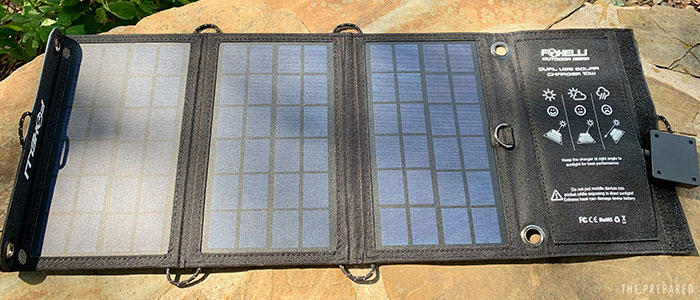
Bottom line: The $45 Foxelli Dual USB 10W is one of the more compact and lightweight units we tested — and also one of the least stable. It bombed pretty hard on the 2A runs, which we can’t hold against it because Foxelli only claims 1.85A max. But we found instability even down to 1A. It did, however, manage a respectable 4.8W average on a cloudless version of that run.
To compare it directly to a similarly-sized competitor, the Choetech, it weighs slightly more and produces about half the power. Not good.
The difference in weight and performance probably comes from the different make of the panels. The Foxelli has a type of panel that in our tests seems to be associated with lower stability under heat, and sure enough you can see that in some of the test runs.
Test notes: In the first run, it started out steady and then went crazy at about the 40 minute mark, with the power fluctuating wildly. On a subsequent run with more sustained sunlight it did better. But on the third run it just went nuts. That third run was the hottest (96F, vs. 80F and 90F on the other two), and the FLIR measured the panel at 110F near the end of the test.
Goal Zero Nomad 14 Plus – (Discontinued)
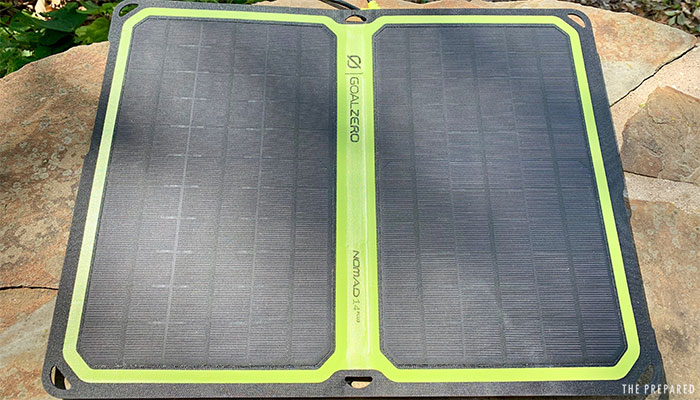
Bottom line: Goal Zero is a major player in the off-grid energy space, and we own and use many of their products. But the $150 Goal Zero Nomad 14 Plus just did not deliver. It’s expensive and heavy, and the output won’t stay stable enough to be usable at anything over about 1.5A of current. The 4.8V at 1.49A (~7W) that it would actually stabilize at is just not even close to good enough, even if it were as inexpensive as one of the other panels.
But at over 3X the price and almost twice the weight of our top pick, there’s just no case for this panel that we can see.
We worked with Goal Zero’s support, thinking we may have received a bad unit, but the results were the same after they sent us replacement junction boxes. We then shared our results with one of their engineers, who suggested we retest at a 1.5A draw — that did produce more stable results, they just weren’t very good results.
Goal Zero Nomad 7 Plus – (Discontinued)
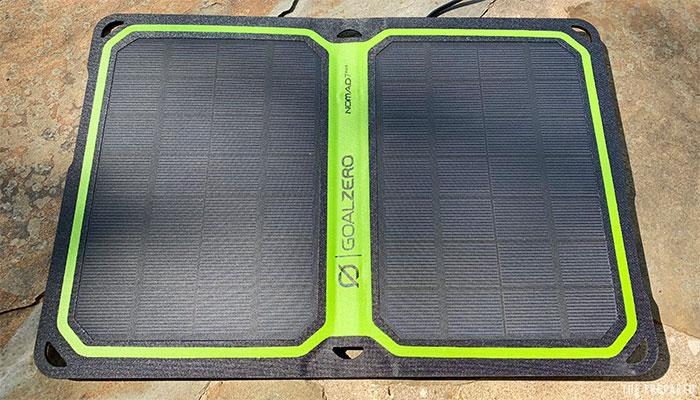
Bottom line: Everything we said above about the Nomad 14 Plus applies to the $80 Goal Zero Nomad 7 Plus, but even more so. For the price and weight, just about every other charger in this guide absolutely wrecks the Nomad 7.
One of The Prepared’s testers even had this same model from a few years ago in their personal preps, and as a result of this review, they’re throwing it out.
We tested at a little over 0.5A current, which is the most we could get out of the Nomad 7 in the full Texas sun and still keep it stable. So this was a 2.6W panel under ideal conditions, placing it dead last in raw power output. Even when you account for the smaller size than the rest of the panels in this review, that’s just not good enough.
iClever USB Solar Charger – (Discontinued)
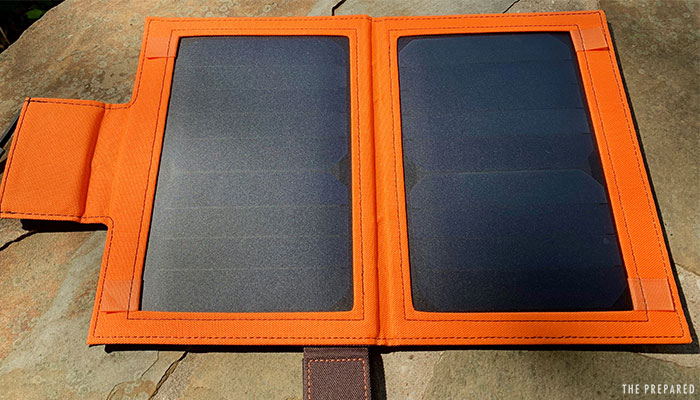
Bottom line: We liked the build and compact design of the $60 iClever USB Solar Charger. It comes with an integrated 8000mAh battery that cannot be removed, which we generally dislike and makes the testing harder. When we eyeballed the panels up close, they look like the same panels in other products that performed well in our testing.
In a future iteration of this review, we may include more chargers with built-in batteries and develop a different testing protocol. The iClever’s battery performed fine in these tests, however, with a very solid 4.8V at 2A.
Nekteck 21W Solar Charger
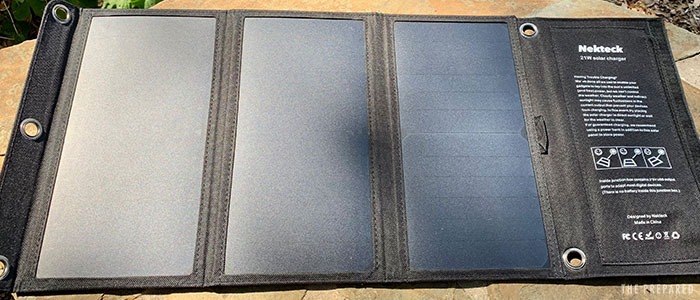
Bottom line: The $40 Nekteck 21W was one of the standout chargers, and it’s very close in design, size, and performance to the Choetech. These two panels are closely comparable, but while the Choetech’s performance is better, the Nekteck’s design is slightly more versatile and durable — it has a flap with three embedded rings on one end, a two embedded rings on the USB port end.
For the weight, price, and performance, it’s clearly at the top of the heap. For just $40 this charger is a fantastic value.
Test notes: The Nekteck’s power output was extremely clean and stable over all the runs, and it matched the sunlight level closely. For the third run, the irradiance meter wasn’t recording, but the sky was clear until around 3pm, when the power output started to drop steadily with a few dips.
RAVPower Solar Charger 16W Solar Panel
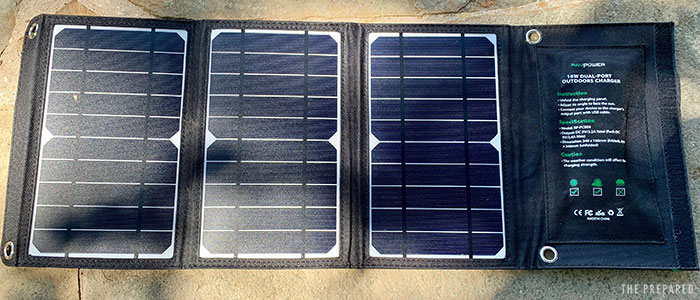
Bottom line: Avoid the $50 RAVPower 16W Solar Charger. We never could get this compact charger to stay stable at 2A, and it underperformed even the Foxelli charger by most metrics.
The RAVPower claims a 5V and 2.4A output, but we never saw output even close to that in our testing. The panel was able to keep the voltage at one of its two USB ports between 4V and 5V pretty consistently, even going over 5V by a decent margin on a few occasions. But the amperage was all over the map, swinging between a little under 2A and zero.
This charger just couldn’t keep enough current coming consistently to break 4Wh under a 2A load. However, if we dial the load back to 1A, we start to get more stability and the charger gets up to 5W consistently.
Looking at the brief periods in the test runs where it did well plus the less-formal spot checking we performed, where we watched the meters for a few minutes but didn’t record, we could see maybe getting this panel up to 7W sustained under absolutely ideal sunlight and load conditions. But even then, it’s not going crack the top 5 in its weight and price class.
Test notes: The second test run of this charger is the only one we saw in this whole review where the unit is clearly having problems getting back up to its power output after a cloud passes. You can see that it’s unstable for about 10 minutes after it’s plugged in, and then that instability returns every time the sunlight level dips due to cloud cover. As for the first run, there was a lot of instability, which really hurt the charger’s average power and total Wh output over the course of the run.
Renogy Portable E.Flex Monocrystalline 10W – (Discontinued)
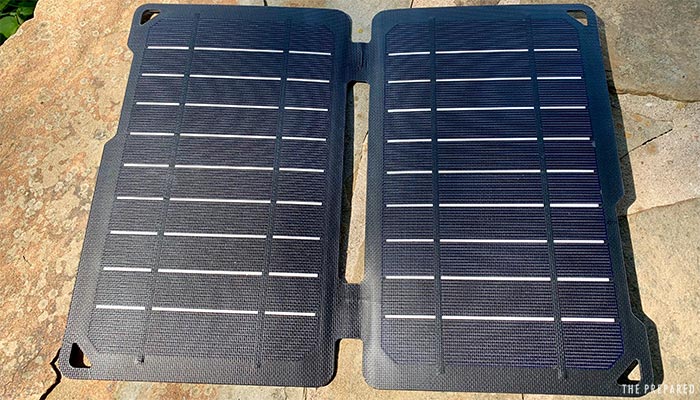
Bottom line: We loved the $30 Renogy E.Flex 10W charger and some of our testers bought a few for their families. The build quality feels insanely sturdy, with the possible exception of the hinges (if squished flat by a heavy weight) and the little plastic box on the back for the USB port, which protrudes in a way that might make it prone to snap off in a pack. But otherwise it feels like a tank, which is amazing considering that it’s only half a pound.
The Renogy scored really high efficiency numbers for its compact size category, and its close to a 5W panel on a good day. It’s sensitive to load, though, so it wasn’t until we dialed the load back to 1A that it reached peaked efficiency.
It stands out for staying stable and continuing to charge even at fairly low sunlight levels. Even under cloud cover, this unit can still put out a clean trickle charge, which is not something we saw with the other smaller panels (or even in some of the larger panels).
Ryno Tuff Solar Charger Dual USB 21W
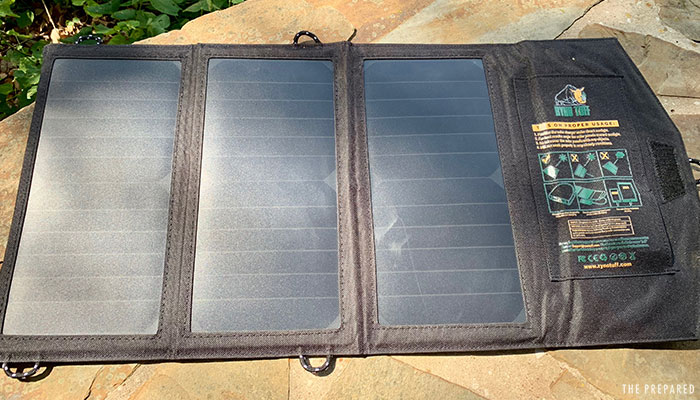
Bottom line: The $57 Ryno Tuff Dual USB 21W unit came out on top in power output, watts per ounce, and price. It was a great performer in every area, and though it wasn’t quite as stable on all the test runs as its closest competitors, overall it out-delivered everyone else.
Test notes: The first two test runs showed this charger doing really well, and it’s clear that it would have scored an average of over 9W of output if the weather had cooperated.
There was a period of instability in the middle third of the second test. This may be related to heat buildup, but it’s hard to say. The third test run was done with a 3A load, and you can see that it’s significantly less stable than the other two that were done at 2A. This instability under a higher load is something we’ve seen in a few of the panels, and as in the other cases, we think the cause is probably heat-related.
Solar Camp 5V 7.6W
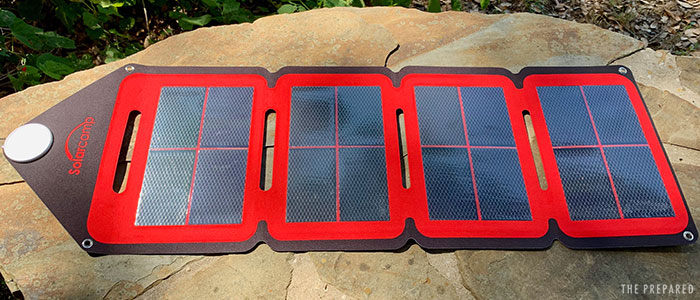
Bottom line: We couldn’t get much power out of the $100 Solar Camp 7.6W on any of the runs where we set our 2A load to perfectly match what Solar Camp claims its port delivers. The charger would not stay stable over the course of any of the 2A runs, and the current just swung all over place.
We finally started seeing some real results when we lowered the draw to 1A. We did a very short run where we were able to get as much as 4.9W out of the panel at irradiance levels of 800W/m2 and higher. If this charger could sustain that kind of output for a longer 1A test run, then that might put this in the running with the Renogy in terms of watts per ounce. But even on a one-hour 1A run where we simulated a clear day by removing the cloud cover from the dataset, the power still swung around a bit and we ended up with 2.7W average.
Ultimately, even though the Solar Camp is lighter and is capable of 4.9W output for short stretches under ideal conditions, we still don’t think it’s really in the same class as the Renogy for two reasons:
- The Renogy’s build quality is off the charts, especially compared to the thin, flexible Solar Camp.
- The Renogy is dramatically cheaper, especially if you get it on sale.
The Solar Camp’s performance may come down to the fact that it is is using a panel design that’s different than anything else in this roundup. You can see from the photo that the panels have a different look to them, and they’re on a thin, flexible backing.
Solar Camp advertises this package as lightweight and waterproof, and while we didn’t test the latter claim this time around, it’s probably valid. This is a very compact charger for the number of panels and total panel area you get. We loved the design and the build. Unfortunately, the performance just isn’t there in our testing.
Test notes: In the first test run, there was one roughly 15-minute stretch where this panel sustained about 2A. But the rest of the time on all the runs the current alternated between zero and 500mA, while the voltage stayed between about 4V and 5V. We have no idea why or how this happened, but have followed up with them to see if we can’t improve on this in a future review.
We did a subsequent test at 1A and got much better results, but it’s still not enough to get this charger into our main recommendations.
SunJack 15W
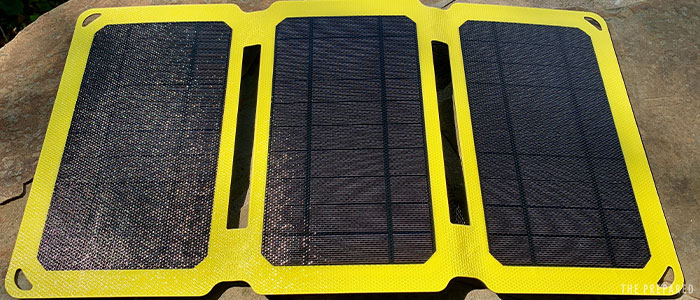
Bottom line: The $80 SunJack 15W is an expensive and moderately heavy panel. The build quality is similar to the Renology charger that we liked: hard plastic and built like a tank. But in terms of power output, it just didn’t blow us away like we had hoped when first pulled it out of the box.
We tested at a variety of attempted current draws, from 1.5A up to 2.8A, and we really couldn’t get this charger to put out more than 9W. We wish we had been able to test on some days with long stretches of over 950W/m2 of irradiance because we suspect we may have seen north of 10W with the right load. But that didn’t happen, and regardless, this didn’t do any better than much lighter and less expensive chargers.
The model we tested does come bundled with a removable 10K mAh rechargeable battery bank that seems decent. Since testing, SunJack has released a model that doesn’t come with a battery and is $20 cheaper, allowing you to pair with a bank of your own choosing.
X-DRAGON 14W SunPower – (Discontinued)
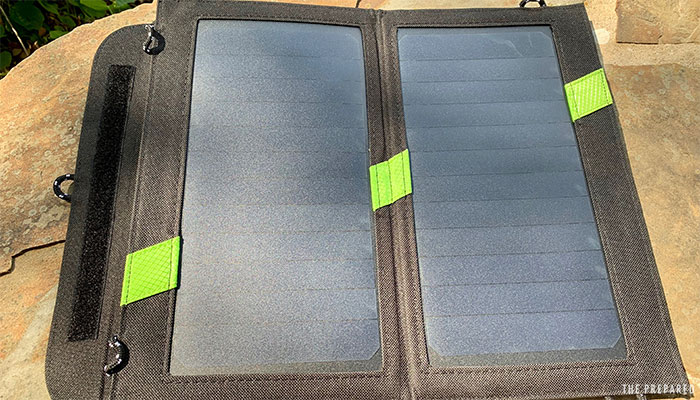
Bottom line: The $40 X-DRAGON 14W is a really great, compact, two-panel charger. It’s lightweight with solid build quality and impressive performance for the size. You’re not going to get a ton of power out of this charger, but under good conditions you can sustain well over 5W, which is quite good for a sub-1-pound panel. This panel was very stable, and it tracked changes in sunlight with near-perfect precision.
But ultimately, as much as we liked this panel, we’d rather either add an ounce and a half and get one of the more powerful chargers like the Ryno Tuff or Choetech, or go all the way down to the Renogy to really save weight. Based on our current numbers, this panel just falls into a weird size/performance spot that makes it hard to recommend, despite our love for it.
X-Dragon also offers a three-panel 20W charger— if it performs like this smaller version, then it’s probably a beast. We’re going to try to get our hands on one for the next round of testing.
Test notes: It’s pretty clear from the middle 30 minutes of the second test run that this panel could probably hold a 7W output in the right conditions, but even then that wouldn’t be good enough to crack the top 4 or so by weight and power.
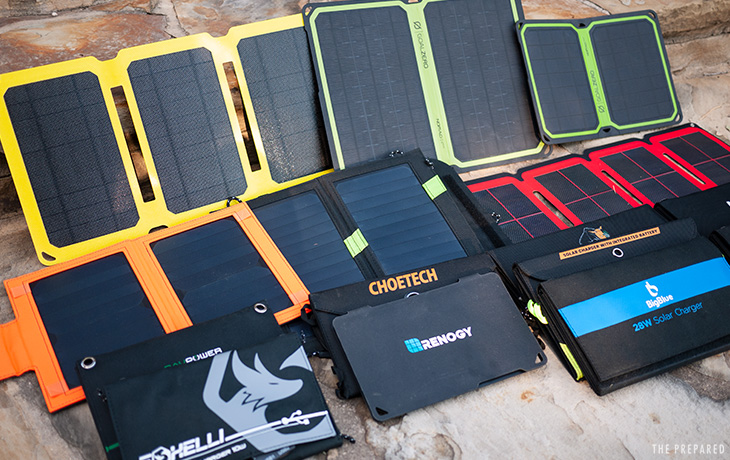
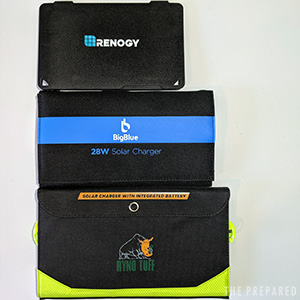
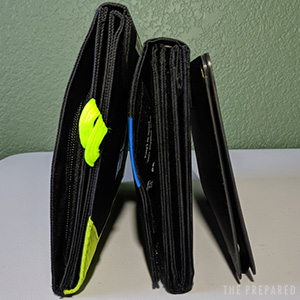
You are reporting the comment """ by on